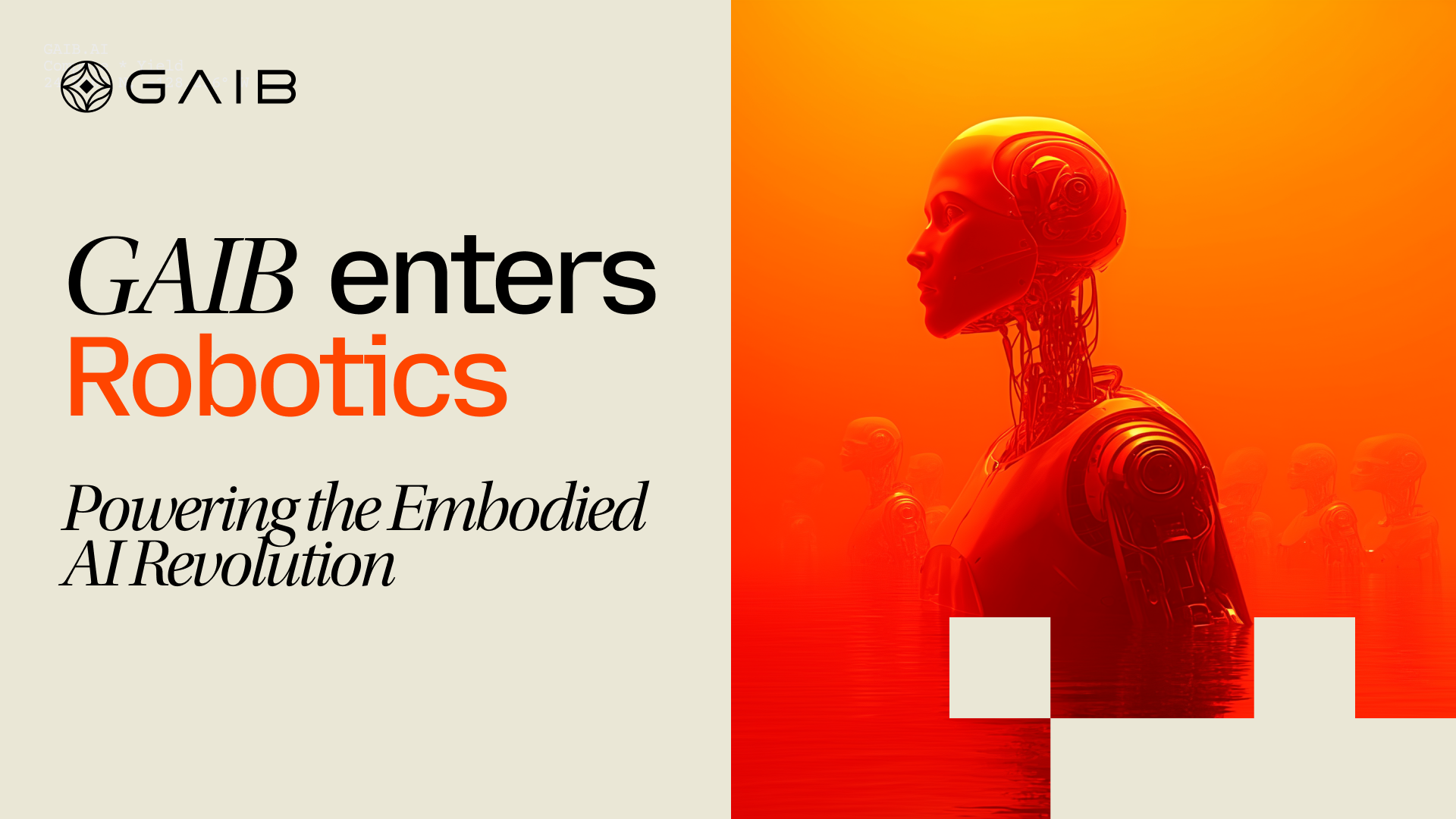GAIB enters Robotics: Expanding into the Embodied AI Revolution

As AI reshapes our digital lives, the next tech frontier is clear: Embodied AI (EAI) — including but not limited to Intelligent Humanoids, Vehicles, etc.
This is where intelligence moves beyond screens and servers, taking physical form in robots and autonomous systems that perceive, learn, and interact with our real world.
Today, we are thrilled to announce a significant expansion of our mission, as we unveil GAIB’s strategic entry into the robotics sector, accelerating the commercialization and adoption of Embodied AI.
Why Robotics?
The global Embodied AI market is projected to experience explosive growth, expanding from an estimated $4.44 billion in 2025 to $23.06 billion by 2030, at a CAGR of 39.0%. This growth is fueled by breakthroughs in deep learning, computer vision, reinforcement learning, and advanced sensor integration, alongside the proliferation of edge AI and 5G connectivity.
Robots are no longer confined to repetitive, pre-programmed tasks; they are becoming increasingly autonomous, adaptive, and intelligent, enhancing human-machine interaction across various sectors.
However, this immense potential is currently constrained by significant challenges:
- Capital Intensity: Producing robotics solutions is a capital-intensive endeavor, demanding substantial investment in hardware, R&D, and specialized talent. TradFi struggles with the novelty, long development cycles, and the unique nature of robotic hardware as collateral. This leads to a concentration of funding in a few large players, leaving many innovative early-stage companies struggling for capital.
- Data Scarcity & Fragmentation: Embodied AI models require massive, high-quality, and diverse real-world datasets for training and continuous learning. Collecting this data is time-consuming, resource-intensive, and often fragmented, hindering model development.
- Model & Software Fragmentation: The robotics industry currently suffers from a lack of common standards and interoperable platforms. This fragmentation makes it difficult to build universal “OS-like” foundations for EAI, slowing down innovation and increasing development costs.
- Hardware Monetization Hurdles: While robots represent significant asset value, monetizing their “work results” or future cash flows beyond direct sales remains a challenge, making it harder for companies to secure continuous funding post-deployment.
Bridging the Gap with RWAiFi

Our RWAiFi strategy builds the infrastructure to tokenize the entire AI economy, transforming it into a decentralized, inclusive investment opportunity. As we bring the AI Infra economy onchain, we are now digitizing the Robotics economy, another multi-trillion-dollar opportunity, enabling everyone to own a piece.
- Decentralizing the Future Economy: We’re bridging the gap by allowing everyone to participate in the nascent EAI market, leveraging blockchain and tokenization to democratize access to this opportunity.
- The AID Token — Your Stake in the Robot Economy: Our synthetic dollar and yield bearing asset products, AID and sAID, will be the gate to the underlying, cash-generating infrastructure of the entire AI economy.
- Unlocking DeFi’s Full Potential for Robotics: By tokenizing robotics, we unlock unlimited possibilities in the DeFi world, enabling seamless trading, lending, yield farming, and staking using these digital representations.
How does GAIB tokenize Robotics?
Same as we tokenize GPUs, allowing investors to own pieces of AI infrastructure through our synthetic dollar and yield-bearing AID and sAID asset pair, we’ll naturally extend this model to robotics sector, adopting the same underlying architecture of GAIB economic layer. This will add value to the AID and sAID assets as a source of investment opportunity and yield.
The Tokenization Layer — From Physical to Digital, Tokenizing AI Infrastructure Assets
We extends our GPU financing & tokenization playbook to robotics, establishing legal structures and technically registering real-world robots and their cash-generating activities onto decentralized blockchain networks. Through our tokenization engine, GAIB converts these physical assets and their associated agreements (such as future returns and ownership) into verifiable Real-World Assets (RWAs) on-chain.
The Financial Layer — Yield from Robotic Assets
Our financial layer acts as a crucial bridge, ensuring that profits from the physical world flow smoothly into the digital ecosystem. Through structuring financing deals (debt, equity, or hybrid models) with robot makers and manages the onramp/offramp processes, the cash flows and returns generated by these physical assets can be seamlessly distributed back to on-chain investors.
AID — Your Gateway to AI Infrastructure Yield (Compute + Robotics)
AID is the first AI Synthetic Dollar, designed to democratize access to AI infrastructure assets. Users can contribute capital and receive AID, which is backed by t-bills and liquid assets. AID holders have the option to stake their tokens to receive sAID. Holding sAID grants you the right to the returns from a diversified portfolio of tokenized GPU and robotics assets. This means sAID holders receive a direct share of the real-world revenue generated by GAIB’s entire AI infrastructure economy, including compute, robotics, and future AI assets.
GAIB aims to make the multi-billion dollar robotics and compute economy accessible to everyone, transforming what were once exclusive, large-scale infrastructure investments into opportunities available to all.
💡For more information on our asset tokenization mechanism, visit our documentation.
How are we approaching the robotics sector?
We tokenize and financialize three main parts of the robotics value chain:
- Robotics assets: financing and tokenization of high-value robotics assets — from individual high-performance robots to entire fleets, as well as their future cash flows.
- Data flows: financing the infrastructure necessary for robust data collection, secure storage, and efficient processing for robotics companies. This could include financing specialized sensor arrays, robot components, and even the platforms that enable incentivized, decentralized data sharing among participants in the robotics ecosystem.
- Production & Supply Chain: tokenizing the infrastructure required for efficient robotics manufacturing and deployment. This includes advanced production facilities, specialized component inventories, and supply chain logistics that support the entire robotics ecosystem.
GAIB is actively working with selected partners in the robotics sector, such as OpenMind, PrismaX, Sahara, Camp Network, SiamAI Robotics and more, to make this vision a reality, with more details expected in the near future.
With $65M in pre-deposits so far and a $2B+ pipeline of compute assets, we can only expect this addition to our business model to add massive value to the GAIB AI economic layer.
Conclusion
We are extremely excited to unveil this upcoming investment opportunity to our users as we build the AI infra economy onchain.
Deposits are now open for the Final Spice, our last campaign until the launch of AID and your last opportunity to be an early adopter of the GAIB protocol. To deposit, visit aid.gaib.ai. X thread

